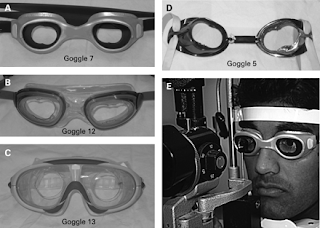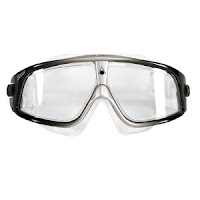 Picture on the left: An iris melanoma, which has an incidence rate of about 4.7 people per million Americans. (photo courtesy of the Mayo clinic)
Picture on the left: An iris melanoma, which has an incidence rate of about 4.7 people per million Americans. (photo courtesy of the Mayo clinic)A good pair of sunglasses could save your life! Although rare, eye cancers can occur in adults due to UV light exposure from the sun. Also, prolonged exposure from a tanning bed, artificial lights, or other UV light sources may damage the eye. Therefore, please be sure to wear UV light protection whenever you are outdoors or exposed to UV light. Even if you are not looking at the light source, the beams may still penetrate around the outside structures of the eye and cause ocular complications.
 Thank goodness that large sunglasses are definitely in style. Keep those shades on and you are not only protecting yourself from cancers, but also from eye diseases like cataract and macular degeneration. Dr. Paull sees patients every day that have 'sun spots' or tiny raised areas on the outer part of their eye called pinguecula. These areas can cause irritation and can grow into larger structures called pterygium that may eventually blur vision.
Thank goodness that large sunglasses are definitely in style. Keep those shades on and you are not only protecting yourself from cancers, but also from eye diseases like cataract and macular degeneration. Dr. Paull sees patients every day that have 'sun spots' or tiny raised areas on the outer part of their eye called pinguecula. These areas can cause irritation and can grow into larger structures called pterygium that may eventually blur vision.
Dr. Paull had an up-close and personal experience with this during her first year of practice. A 55 year-0ld male patient had a suspicious brown spot in his otherwise clear blue eyes, and Dr. Paull noticed that it had not been documented in any previous exams. He was sent to Duke for some special tests, and it was determined he had a rare iris melanoma that was growing very rapidly. It was quickly excised, before spreading to other areas of his body. He stated that he had been a lifeguard for many years of his life, and he often didn't wear sunglasses while out in the sun.
Therefore, Dr. Paull wants to see all of her patients (young and old) to be sunglass models this spring! Grab your favorite pair of sunshades when enjoying this beautiful weather!
(more information may be found at: http://www.webmd.com/melanoma-skin-cancer/tc/eye-intraocular-melanoma-treatment-health-professional-information-nci-pdq-general-information#s2.1)


 Happy swimming!
Happy swimming!
